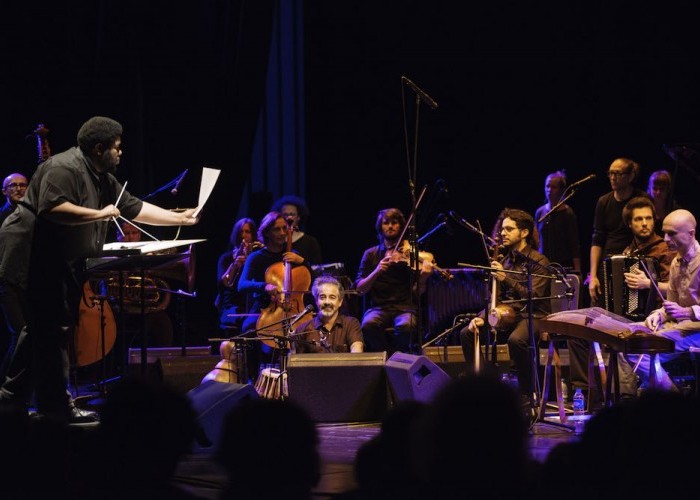Oct 28, 2025 10:47 AM
In Memoriam: Jack DeJohnette, 1942–2025
Jack DeJohnette, a bold and resourceful drummer and NEA Jazz Master who forged a unique vocabulary on the kit over his…

Tyshawn Sorey (left) leads a “conduction” performance at this year’s Berlin Jazz Festival.
(Photo: Camille Blake)The Berlin Jazz Festival handily accomplished a two-fold mission to preserve its prodigious historical legacy while keeping the music fresh and contemporary during this fall’s 54th edition (Oct. 31–Nov. 5). Artistic Director Richard Williams, a seasoned British critic/journalist, presented an impressive and balanced program, the third of his three-year contract as festival head.
Williams managed to find footing in the many niches and subcultural byways making up jazz in our moment. Among the “straighter” high points of the six-night program (expanded from the usual four nights) were the NDR Big Band in handsomely understated Norwegian mode, with guests pianist Geir Lysne and gleaming vocalist Solveig Slettahjell, and organist Lonnie Smith’s mighty trio. An inventive balladic agenda shone through on the Nels Cline Lovers project, and German pianist Michael Wollny generated much buzz with his rare solo piano set, revealing his breadth, organic technical aplomb and unapologetic sentimentality. It all ended with John Beasley’s adventurous MONK’estra big band tribute to Thelonious Monk at 100.
But many of the sets took a more adventurous path. A short list of festival highlights this year would have to include the cerebrally but also viscerally dazzling young trio known as Punk.Vrt.Plastik—with Slovenian-born pianist-of-note Kaja Draksler, uber-nimble German drummer Christian Lillinger and the stellar Swedish bassist Petter Eldh—and trumpeter Ambrose Akinmusire’s socio-historically charged project written for this occasion, Mae Mae, a blues-rooted suite.
Steve Lehmann & Sélébéyone, one of the stronger jazz-meets-rap projects to date, sparked up the venue Lido, an inviting funky-around-the-edges nightclub in Kreuzberg. In a very different “alternative venue”—the polygonal chapel next to the bombed-out Kaiser-Wilhelm-Gedachtnis-Kirche memorial site on the major avenue, the Ku’Dam—the festival returned with a powerful, meditative Sunday afternoon event. This year’s “festival goes to church” visit featured the alluring, primal and mostly improvisation-driven Trondheim Voices, with British keyboardist Kit Downes showing his considerable chops and flowing imagination as a pipe organist.
Interspersed throughout the week in Berlin, drummer Tyshawn Sorey—who had made a bold impression as part of Myra Melford’s group at last year’s fest—showed up on multiple stages and asserted his multifaceted voice as the festival’s new artist-in-residence. With musical talent that extends into areas beyond his obvious mastery as a drummer, Sorey’s star has been rising of late, and the Berlin residency is another confirmation of his importance.
Sorey’s climactic appearance in Berlin was in the setting of his masterful work as a “conductionist,” deploying an intricate series of commands and gestures over a varied large ensemble and creating an evocative hourlong work before our ears. Sorey, who may well be the heir apparent to the late “conduction” master-founder Lawrence “Butch” Morris’ legacy, demonstrated that he can work magic with groups of musicians not necessarily ingrained in jazz or free-improv ways.
In drummer mode, Sorey appeared on the main stage with his trio to explore the sensitive terrain of music from his acclaimed album Verisimilitude (Pi). The music ranged, without dogmatic or “ism”-related limitations, between avant-jazz venturing and the scored vistas of a “new music” aesthetic, sometimes echoing the poetic time-lapse qualities of the late Morton Feldman’s music.
In a way, Sorey ventured more freely in the role of drummer-conversationalist and while creating a flexible foundation for two powerful German saxophonists. Very early on Friday evening, he was a dynamic and empathetic foil, along with bassist Chris Todoni, for the omnidirectional saxophonist Angelika Niescier, who had just won the Albert-Mangelsdorff-Preisverleihung (Deutscher Jazzpreis) before winning over the audience in the hall. Sorey returned late on Friday night to square off with veteran tenor saxophonist and bass clarinetist Gebhard Ullmann in a free-ranging duo set that fluidly ran a gamut of intensities and ended well past midnight. DB

Jack DeJohnette boasted a musical resume that was as long as it was fearsome.
Oct 28, 2025 10:47 AM
Jack DeJohnette, a bold and resourceful drummer and NEA Jazz Master who forged a unique vocabulary on the kit over his…

D’Angelo achieved commercial and critical success experimenting with a fusion of jazz, funk, soul, R&B and hip-hop.
Oct 14, 2025 1:47 PM
D’Angelo, a Grammy-winning R&B and neo-soul singer, guitarist and pianist who exerted a profound influence on 21st…

Kandace Springs channeled Shirley Horn’s deliberate phrasing and sublime self-accompaniment during her set at this year’s Pittsburgh International Jazz Festival.
Sep 30, 2025 12:28 PM
Janis Burley, the Pittsburgh International Jazz Festival’s founder and artistic director, did not, as might be…

Jim McNeely’s singular body of work had a profound and lasting influence on many of today’s top jazz composers in the U.S. and in Europe.
Oct 7, 2025 3:40 PM
Pianist Jim McNeely, one of the most distinguished large ensemble jazz composers of his generation, died Sept. 26 at…

Drummond was cherished by generations of mainstream jazz listeners and bandleaders for his authoritative tonal presence, a defining quality of his style most apparent when he played his instrument unamplified.
Nov 4, 2025 11:39 AM
Ray Drummond, a first-call bassist who appeared on hundreds of albums as a sideman for some of the top names in jazz…